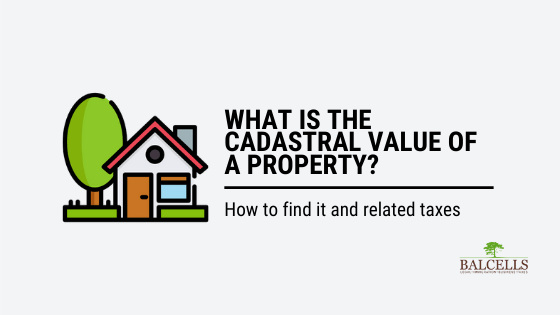Whenever you decide to buy a property in Spain, this word appears early on the process. No matter if the purpose is to reside or to invest, knowing the cadastral value is essential. And in this article, we will go over the main issues related to this concept. What is the cadastral value of a property and how can you calculate it? If you want to know the real price you will pay for your new property and all the taxes to be paid… Knowing this amount will be key!
What is cadastral value?
The cadastral value is the value that the Spanish administration gives to each property, based on data found on the land registry. Hence, it can be used as a pretty good estimate of the capital value of the property.
On the flip side, it is the amount you should consider when computing many of the taxes related to buying and owning a property in Spain.
It is calculated upon several criteria approved by the municipality in which the property is located. We will see them in a minute.
But just to give you a broad reference, it is usually much lower than the market value of the property. And also consider that the cadastral value can never be larger than the market value.
Nevertheless, bear in mind that it can be updated each year by using several formulas approved on the budget laws.
Why is cadastral value so useful to know when buying a property?
In case you are planning to invest in Spanish real estate or to buy a new home, knowing its cadastral value will be crucial.
Why?
Because it sheds light on many information you really want to know before the transaction. Basically, it will help you know how much you will end up paying:
- Buyers will never sell below cadastral value. And that is because they may be having trouble with the Spanish Tax Agency. Hence, you now know which is the minimum price the seller is willing to sell the property for (its cadastral value). This will be really useful for negotiation purposes and to compare prices among different properties.
- Taxes. It is the cadastral value that you take into consideration when paying taxes to both the Spanish Government and to your town hall. Therefore, calculating the cadastral value will let you know how much tax you will pay when buying the property and when owning it. You know the tax rate, and you know the base. So you can also compare among properties based on real final numbers.
Cadastral value and property taxes
As we mentioned, the cadastral value is especially important when taking into consideration the taxes you will pay for your property. And that will be true no matter if you are a resident or a non-resident in Spain.
In that sense, let’s see which are the taxes that use the cadastral value as a reference to be computed:
Non-resident Income Tax
If you spend less than 183 days per year in Spain (you are a non-resident), you should pay this tax on the incomes obtained in Spain.
If you are not renting out your property, you will still pay a small percentage as if you were renting out. So what the tax agency does is to create an imaginary income; the income you would obtain if you were actually renting the property, so they can charge you a percentage.
The base to which they apply that percentage is the cadastral value.
How does it work exactly?
It’s simple. The non-resident income tax is obtained by applying a flat rate of 24% to 1.1% or 2% of the cadastral value (depending on when the valuation was made).
If you want to learn more about the non-resident tax and how it works, you can do it here.
Real Estate Tax or IBI
The IBI (“impuesto sobre bienes inmuebles”) is a tax you pay to the town hall in which the property is located.
Again, the tax base in which the percentage is applied is the cadastral value. That percentage ranges from 0.405% to 1.166%; depending on the specific region.
This tax must be paid once per year by the legal owner of the property.
Plusvalía
Plusvalía is a tax included on the income tax or in the corporate tax that must be paid by the seller.
It is levied on the profit generated by the increase in the value of the property from the moment of the purchase in comparison to the selling time.
Some reasons such as the improvement of the roads that surround the building help to explain that increase in value.
Basically, it depends on the cadastral value and the number of years the property has.
You can learn more about how it is computed and how to avoid paying it here.
Wealth tax
Finally, the wealth tax is a progressive tax that is applied to your worldwide assets if you are a resident, or to your Spanish assets if non-resident. But only in case they exceed the total amount of 700.000€.
It goes from 0.2 to 2.5%.
When computing the wealth tax payment in regards to your property, the tax agency takes into consideration the largest amount of the cadastral value, purchasing price agreed with the seller, and the value they recognize as valid after some calculations.
Which are the criteria used to compute it?
There are several factors that affect and define the cadastral value of a property. Specifically, we are talking about:
- The exact location of the property and the composition of its surroundings
- Circumstances that affect the land in which it is situated, like its quality
- Profits obtained from commercial activities
- Number of years
- Market conditions
- Everything related to the production of the property and its value: production costs, taxes, usage, etc.
- Renewals and the value they added (if applicable)
As you can see, we are not talking about a number you can guess straightaway.
There are many factors that influence it, so the best alternative is to check it on the available sources we will explore now.
How to find the cadastral value of a property
Before starting, let’s clarify that accessing this information is completely free.
There are several ways to access the cadastral information of a real estate asset.
That information can be accessed by anyone, as long as it does not contain any protected piece of data. Nevertheless, if you would like to know about the owner’s name or specific cadastral value of the property, you will only be able to do it is as long as:
- You have an authorization
- You are the owner
- You can demonstrate that there is a special interest with the property
So let’s suppose you meet one of the 3 mentioned scenarios. How to access that information?
Basically you have two options.
First of all, you can wait to get the real estate tax (IBI) receipt. The cadastral value is clearly outlined there.
Nevertheless, if you don’t want to wait for that, there are other available options. You can go to the Land Registry office and request it personally. Bear in mind that you will have to identify yourself with a valid passport or ID.
Finally, there is also the online way. You can access the relevant website of each Autonomous Community and check it out there.
Each region has its own criteria and method, but the main ones:
- If the property is in Catalonia, you can do it here
- In case you are in Madrid, this is the link
- And for properties in Valencia, the cadastral value can be accessed here
Learn more about the real estate process in Spain
Would you like to learn everything you need to know about buying/selling/owning a property in Spain?
Then, good news!
We have a section in our blog that will provide all the information that you are looking for as an expat. From the process to buy a property in Spain to all the related taxes.
Access our Spanish property news here.
And, even better news, our lawyers are always ready to help you out with your real estate needs. Let us make things easy for you.
Book a consultation with one of our lawyers and solve all your doubts:

At Balcells Group we have been foreigners effortlessly moving to Spain for over 11 years. We help expats from all around the world with their immigration, business, tax and legal needs; ensuring a legally safe and enjoyable transition to the Spanish territory. Our multilingual team understands the importance of adapting to the cultural and legal specificities of our international clients. We offer a comprehensive service that combines the expertise of several generations of lawyers with the innovation needed to address today’s legal challenges, always striving to simplify processes and ensure reliable, effective results.



